My Gardening Calendar of things to do.
January
It may be hard to notice but the days are starting to get longer. However the cold Winter months make it impossible to do very much outdoors. Take advantage, put your feet up and make plans for the coming Spring and Summer.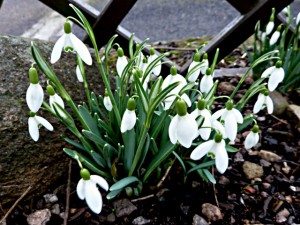
Order your Summer bulbs, seeds and plug plants of, Begonia semperflorens, Impatiens and Pelergoniums.
Do take advantage of any milder days and clear the leaves which have still been gathering on the lawn. Don’t walk on the grass on those frosty days though, it is surprising the damage that can be done by doing so. Also in mild periods, plant out bare rooted trees, shrubs and Roses.
If there has been heavy snowfall, brush it off the conifers, hedging and Box topiary to prevent damage.
Cut back the dead stems from your Herbaceous plants, some of them like Sedums and Phlox you may already see fresh shoots emerging, take care not to damage these.
Prune Wisteria, cut back last years growth to just three buds from the main stem
February
Very much a time to catch up on the jobs that you didn’t manage to get done in January.
Do you have a garden which explodes with colour in the Summer months and the rest of the year, especially Winter looks rather drab. Our garden was very much like this at one time. 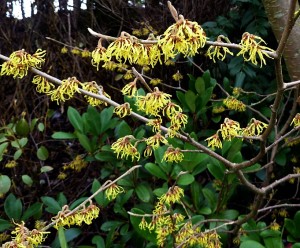 Gradually over the past five years we have transformed it into a garden for all seasons. Perhaps you could think about this, check out the link below for Winter garden plants.
Gradually over the past five years we have transformed it into a garden for all seasons. Perhaps you could think about this, check out the link below for Winter garden plants.
Plants for the Winter Garden.
Firm around any Perennial plants in the borders which may have lifted with the frost.
At the end of the month, cut the Summer flowering Clematis hard back, Viticella’s for example. Do make sure which Clematis you do have as some require light pruning.
If you have not already done so this is a good time to prune most deciduous trees, before the sap starts to rise. There are some exceptions, the Horse chestnut, Birch, Walnut and Cherry trees bleed extensively, prune these in mid Summer when new growth has matured.
Tidy up the flower beds, the Snow drops will have started to flower. The Daffodils and Crocus will be well through the ground, hints of Spring just around the corner.
Late February is the best time for pruning Roses. Click this link and scroll to the bottom of the page for information – Pruning Hybrid teas and Floribundas
March
Time to get those tuberous Begonias started off in the greenhouse. Bed them into a shallow amount of general compost in seed trays then simply cover the tubers or corms with the compost, label and water them in.
I like to have the greenhouse temperature set so it falls no lower than 52d Fahrenheit.  Also for earlier flowering Dahlias get the tubers started into growth by potting them up now.
Also for earlier flowering Dahlias get the tubers started into growth by potting them up now.
Prune back the winter flowering Heathers when the blooms fade.
The lawns probably looking tired at the moment. Use a tine rake to get rid of the moss. I find the plastic ones are better to use than the metal ones, also not so severe on the lawn.
Plant container grown Trees, Shrubs and Roses.
April
April, Spring one minute and before you know it the Daffodils are flattened with the snow.Never mind lets enjoy those moments of warmth in the sunshine while we can.
The Garden centres may be overflowing with Summer bedding plants, don’t be tempted to plant them out. Here in the north east wait until the 1st of June.
Here in the north east wait until the 1st of June.
Sow half hardy annuals in the greenhouse.
Tidy up the borders, get rid of the weeds which are now growing at great speed.
Prune Summer flowering shrubs, Buddleia, Hydrangeas, Lavatera, Hardy Fuchsias, and when the flowers have gone over cut hard back about one third of the Forsythia branches.
Dead head the Daffodils when the flowers go over to preserve energy in the bulbs for next year. Don’t fold the leaves over and tie them up, just leave them to die back naturally.
The lawn will be due it’s first cut of the season if you live in the Aberdeen area. Set the Lawn mower a bit higher for the first cut. At the end of the month apply a little lawn fertiliser
May
This is the time of year when the warmer days tempt us to plant out the Summer bedding and and get the hanging baskets in situation.
Here in Scotland we can still have the late frosts which can be very damaging.
Bedding plants, best to wait until the first week in June. If you happen to be in a sheltered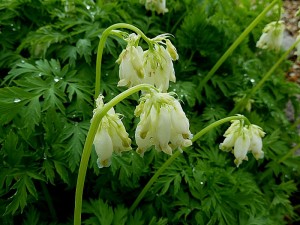 spot you could hang out the baskets at the end of the month. Keep your eye on the weather forecast, if it looks risky take the baskets down and place them back in the greenhouse until the danger has passed.
spot you could hang out the baskets at the end of the month. Keep your eye on the weather forecast, if it looks risky take the baskets down and place them back in the greenhouse until the danger has passed.
Pinch off the dead heads of Daffodils and Tulips to conserve energy in the bulbs. Leave the foliage to die back naturally only cutting it away when it has become brown and dried up.
Rhododendrons and Azaleas which have gone over can be dead headed. Just snap them off cleanly making sure you don’t damage the new young leaf shoots which are emerging. If there is resistance when removing the dead flower heads, leave the job till next month.
If your lawn happens to have a lot of weeds coming through, this is the time to get going with the weed and feed treatments available at the garden centres. Take it easy and don’t be too heavy handed, keep well enough away from the flower border edges.
Feed container plants with a liquid fertiliser, Agapanthus and Lilies will benefit with tomato food.
When the Clematis Montana has finished flowering, give it a good tidy up. After a number of years this one can become a tangled mess. In fact I have known it to completely smother and kill a deciduous tree if used as a host.
June
Everything in the garden looking fantastic, the first month of Summer we have all been waiting for. The leaves of Trees and shrubs still fresh, Roses starting to bloom, and the hard work of Spring showing dividends.
and the hard work of Spring showing dividends.
Time to plant out the summer bedding, Begonias, Impatiens, Petunias and Marigolds etc. I always try to get this done in the first three days of the month. Here in Aberdeen its not that unusual to get a cold snap in the first couple of weeks of the month. The young plants always show their displeasure, however they do recover.
The Privet hedge should be ready for the first cut of the season. This past Winter was colder than usual, our hedge lost almost all of its leaves, recovery was well under way by mid April. Box hedging and topiary can also be trimmed this month. Hope you have not been as unlucky as we have and been hit with the dreaded Box Blight.
Our Box Hedge Destroyed with Blight.
The Daffodil leaves should be ready to cut back this month, leaving the border free to perhaps plant a few Summer half hardy annuals.
June is usually the driest month of the year and the most likely reason for losing perennials which were planted in Spring, is drying out. Do take care to water profusely in dry spells. Water only in the early morning or evening to prevent scorching of the leaves look out for those annuals drying out also.
Keep on top with regular lawn mowing, if you want it looking its best mow at least once every seven days, and also keep well watered. Take care with the feeding regime, stick to the instructions on the box, as overfeeding can be as harmful as starvation.
Weeds are growing very fast at this time of year. Not only do they look unsightly, they draw out a lot of moisture from the soil. Get out the hoe regularly, personally I prefer to get in about with the hand fork
July
Well here we are in mid Summer. So much time is taken up watering, the hanging baskets are most at risk. Further south they generally require watering every day at this time of year. Here in Aberdeen we can usually get away with every 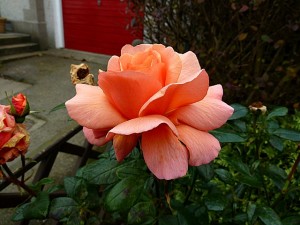 second or third day, unless of course we experience one of our rare heat waves.
second or third day, unless of course we experience one of our rare heat waves.
July of course is the time to sit back and enjoy the fruits of your labour. However many of us simply have difficulty sitting back for five minutes. Fortunately there is always plenty jobs to do in a garden.
Summer flowering shrubs should be tidied up prune back wayward and dead branches. Continue dead heading the Rhododendrons and Azaleas ,also feed them with an ericaceous type fertilizer.
Dead head Summer flowering annuals regularly to encourage the formation of new buds throughout the Summer.
Keep a look out for the pale brown rust spots on the Roses. At the first sign buy a suitable fungicide from the garden centre read the instructions carefully and carry out the spraying programme as recommended. I know it is not something we are keen on, however if you spray late in the evening it will be much less harmful to the environment. Final feeding of your Roses should be carried out this month.
Some of the early flowering perennials such as, Astrantias, Geraniums, Lupins and Delphiniums can produce a second flush of flowers if you cut the stems down and apply a liquid feed.
Now is the time to give your Wisteria its second prune of the year, cut back the whippy shoots leaving about 12 inches. Check my plant profile below for more information on Wisteria.
August
Most of us holiday either July or August. Well lets face it, hardly the best time of year for gardeners. Borders dry out, as does baskets and containers. Ask a neighbour to help out with the watering, or you could install one of those irrigation systems.
Still time to sow seeds of Spring flowering plants, such as, Bellis, Polyanthus and Forget me nots, if done at the beginning of the month.
if done at the beginning of the month.
The herbaceous border is at its best. Phlox, Asters, Day Lilies and shrubs such as mop head and lacecap Hydrangeas are looking fantastic. All your hard work has paid off. Spaces in the border where early flowering plants have gone over can be brightened up by placing container grown Agapanthus, Lilies, or Dahlias.
Hedges such as Privet can be trimmed several times each season, Beech is best cut and shaped only the once and August is the time of year for this job. Yew hedges are very forgiving and benefit with trimming several times between Spring and late Summer.
To prolong the flowering period of Annuals continue dead heading Impatiens, Marigolds and Begonia Semperflorens.
Flowering stems of Lavender plants which have gone over should be cut back now with secateurs. After doing this, with a sharp set of garden shears lightly trim the whole plant without going into the hard wood. In our Aberdeen garden the common Lavender Angustifolia is late in coming into flower and is still in bloom come September. Obviously pruning can be held back when this is the case, however never later than the third week of September.
Take cuttings of Fuchsias and Pelergoniums and grow on for next Summer.
Keep garden ponds aerated by adding water from the hose, not quite so important if you have a filtering pump with fountain.
September
Summer drawing to an end, some days feeling Autumnal with others reaching July temperatures. This is the month to lift and store those root vegetables before the quality starts to deteriorate. Collect seeds and beans for sowing next year. September is the best month to take hardwood cuttings from the fruit bushes. Dig up those Strawberry runners and get them potted up.
September is the best month to take hardwood cuttings from the fruit bushes. Dig up those Strawberry runners and get them potted up.
Visit the garden centre and check out the numerous Spring bulbs now on sale, September is the month for getting them planted. If you are looking for one of the shorter Daffs, I would definitely recommend Jetfire.
Start pruning back the hardy perennials, leaving the ones which can look good in Autumn with decorative seed heads. Remove the fading annuals from the borders making way for your Spring display.
Take a good look around your garden, what about those new herbaceous plants, have they been planted in the best situation, if not get them replanted now.
What about your fencing, is it like mine and requires a coat of wood preservative. Best to get it seen to now before the cold weather puts us off.
Time to get the greenhouse cleaned up in preparation for the container grown plants which require a little added protection, and of course line the greenhouse with poly bubble wrap.
Most of all take time to appreciate those warmer days of September instead of concentrating too much on the fact that Summer is more or less over.
October
This month we really do have to concentrate on getting the garden and greenhouse prepared for Winter before the weather condition starts to put us off altogether.
Get those container plants placed in the greenhouse for protection. You will regret not doing so,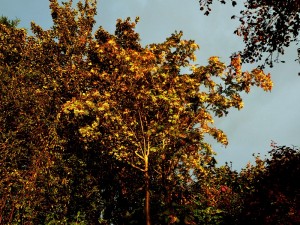 especially if this coming Winter turns out to be as severe as 2009/10.
especially if this coming Winter turns out to be as severe as 2009/10.
Still time to get Spring bulbs planted in the borders, if you didn’t manage to complete this last month. Also plant Daffs, Tulips and Hyacinths in containers, you will be glad you did this, come next Spring.
Lay a good mulch of garden compost around shrubs, use ericaceous compost for the Rhododendrons and the Azaleas. Keep the compost a couple of inches away from the actual stems of the shrubs.
October is a good time for planting out new perennial plants, no concern regarding drying out when planted at this time of year.
Dress borders with bonemeal, also fork your lawn and apply an Autumn feed, make sure not to use your Spring/Summer feed at this time of year.
Remove Summer bedding and replant with Spring plants of your choice, Polyanthus, Forget me nots, Bellis, Pansies and Violas.
Lift those Begonia tubers, dry them off in the greenhouse, wrap them in newspaper pop them in cardboard boxes and place in your loft over Winter.
November
November, very often the wettest month of the year, and the frosts have arrived, also a chance of the first snowfall of Winter if you also live in the North east of Scotland.
Still plenty of work to be done, no point in letting the weather get us down. Bare rooted Roses which you may have ordered usually start to arrive by mid November.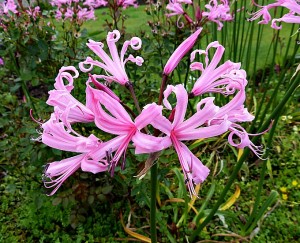 As long as the soil is not frozen, get them planted out ASAP – Click for Rose planting and pruning info (scroll to bottom of the page)
As long as the soil is not frozen, get them planted out ASAP – Click for Rose planting and pruning info (scroll to bottom of the page)
Continue tidying up the borders and lawn, lift and compost the leaves which usually take about a year to break down, making fabulous leaf mould for top dressing and digging in.
Tidy up the garden pond marginal plants. Remove fallen leaves and if your pond is not too large, cover it over with netting to prevent rotting leaves contaminating the water.
If you didn’t manage to give your lawn an Autumn feed last month, there is still time, if you do this job in the first week of November.
Last chance this month for planting Spring bulbs.
Protect tender plants from frost, Cordylines, Phormiums, place them in a sheltered spot cover with fleece or if they are not too large overwinter in the unheated greenhouse.
November is a good time for planting hedging, bare rooted plants are available in good garden centres.
Fruit trees planted this month will give maximum time to have a good root system formed come Spring
December
Probably the best gardening related jobs this month are those done indoors. The seed catalogues will have started to arrive giving you plenty of time over the next couple of months to decide on your Summer bedding. A particularly good way for bedding plants is to buy small plugs, reasonably inexpensive and reliable. Check out this mail order company, I have used them and been very satisfied with the results – Gardening Direct.
Check out this mail order company, I have used them and been very satisfied with the results – Gardening Direct.
Cut down perennial flower stems which have died back, wait until there is no green shoots showing as it can be damaging to the plant otherwise.
Continue clearing up leaves from borders and lawns, do avoid walking on the grass when there is hard frost.
Deciduous Trees can be pruned on mild days, well as long as its not frosty. The exception to trees which require pruning when dormant are Birch and Cherry, prune these in mid Summer.
Remember to cut the water supply to outside taps and those in the garage. I did forget to do this many years ago shall I say, much to my regret.
Place your tender container plants in the unheated greenhouse if you have not already done so last month. Even those left outdoors that may not be so tender would benefit by wrapping with pollybubble.
If your garden looks bare, consider a few changes which will give a bit of added interest. Check out your garden centres, also take a look at these plants and shrubs which look good in Winter – (Plants for Winter Interest)
Do remember to feed the garden birds, and may you and your family have a very happy Christmas

It was November, apologies
I think this must be the missing link Robyn https://www.aberdeengardening.co.uk/2010/11/penny-lane-climbing-rose/
Robyn, I can see no mention of Roses in my October section. Have another check and get back to me.
Please could you guide me to the bit on roses in October? (Click for Rose planting and pruning info (scroll to bottom of the page)
I can’t seem to find it?
I have your page saved and have been using it for around 9 years now! It’s my go to at the start of each month.
Hi Elisabeth, thanks for visiting my site and also for taking the time to get in touch with me. The photos covering the text, I have checked on several computers and mobiles and am unable to replicate this problem. I will make further checks with the technical guys. As you can see, all of my blog posts are about plants in our garden. I usually add the common name within the text but apologize if I have missed this on occasions.
Hi. The photos of plants cover your words. What’s the point of that? Most irritating!
Also, could you add layman’s names for plants. I want to care for my garden but have to stick with easy info.
Many thanks.
Rubella is a male plant, both male and female bloom, if you want berries you have to look up the female forms and make your purchase, plant it quite nearby. I dont think you can tell the difference out of season.
I am looking for skimmia japonica rubella and need to know if I need to buy a male and female plant and how can you tell the difference out of fruting season? Don’t both male and female bloom?
Hmmm yes I can just see it now, ‘well I had great success this year with a nice new plant it has red petals and light green foliage and its next to the plant with purple leaves’ Hmmm don’t think so Alistair, although thank you for the compliment I shall leave this to you experts for now 😉
Always very pleasing to have been of some help Paula. I think you should start your own gardening blog.
When I left Banff for my trip offshore at the beginning of October my garden was still in full bloom with green leaves and lush stalks. I know that when I go home around the 26th of October this will all have changed. The weather here up in the very North of the North Sea is quite chilly but sunny which can be quite misleading and give a false sense of good weather at home. I have been following the weather reports and it seems that the North East of Scotland has been full of cold rain and low pressure fronts which will have decimated my garden and I will go home to a totally different situation. The flowers, lush stalks and green leaves will have disappeared and turned brown and gold. Realising this gave me a moment of panic ‘What do I do?’ I turned once more to your Gardening Calendar. Once again it has been very helpful reading, as I shall have to hurry to get the garden put to bed and your calendar has all the help and hints I will need to ensure that my garden looks lovely once again next spring. My garden has come on leaps and bounds since I have been following your calendar – a big thank you once more…. Panic over 🙂
Charles, I have had success with Penstemons, don’t cut them back until Spring and then take the stems right down to where the new shoots are, even if its almost at ground level. Osteospermums never came through the Winter in our frosty garden. Your Lobelia is very much borderline hardy and you would be doing very well to have success. A really good hardy one is Hadspen purple.
Would like some local advice on ‘perennials’ I’ve got and whether they might not survive the Aberdeenshire winter…Penstemons,Osteosprermums and Lobelia Fan Scarlet. I’m leaving them in the ground this winter and just try and protect them from severe frost with a fleece cover. Do you think it might work or am I being too optimistic? Would like to echo the previous correspondent…It’s great to be able to yap about local plant survival and conditions on your site
Thank you lol. I shall print this off and stick on my shed door once lamiated 🙂
My goodness Paula, I have now appointed you my manager.
I must say that this is the most helpful blog. I know exactly what to do now all year round and will try to follow it around my offshore rota which sometimes can mess up my planting. Your blog is fantastic for us fledgling gardeners
Yes Charles, it will take time to adapt. Acers grow very well in our garden, I guess you will have to get a more sheltered position for yours.
Just moved up to Aberdeenshire (Rothienorman) last autumn. Did fall into trap of putting out some annuals too early.Didnt have a green house in Hampshire but got a lean to up here and it is proving essential in bringing plants on early. It’s facing south and even in March April when the sun’s out the temp. zooms up so its not easy trying to not dry out pots even in March April. I find there’s a lot of wind up here and my Acers dont like wind…most of leaves blown away.
Hi Alistair, I spent my morning reading your blog and looking at the photos. I learned a lot. Thanks for the pointers.
Hey, your blog rocks. You know it is rare to find decent stuff on these things.